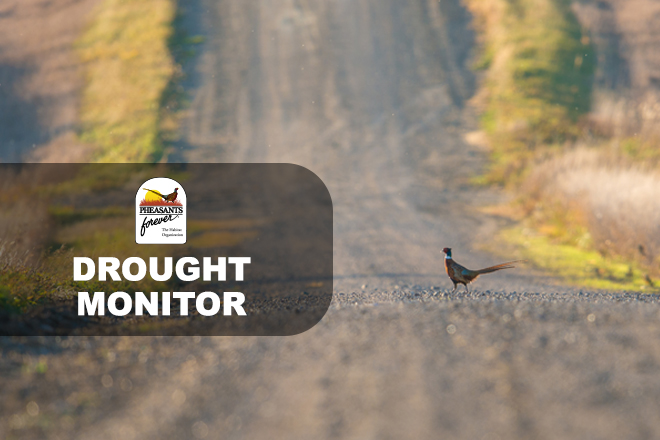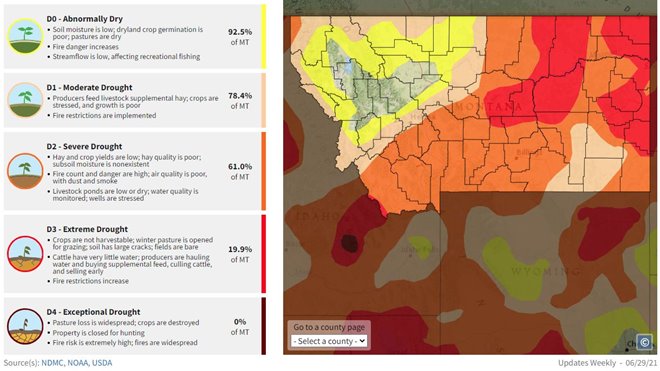
The struggle is real for Montana ranchers and wildlife
By Joshua Hobbs and Erin Fairbank
The drought in central and eastern Montana continues to hang on and worsen, making ranchers and wildlife managers worry about the short- and long-term future.
Currently, 92.5 percent of Montana is abnormally dry, with 80.9 percent in severe to extreme drought conditions (categories D2-D3). There are already fishing restrictions on multiple rivers due to high water temperatures and low flows.
The range just gets crispier, browner and more flammable by the day.
With temperatures ranging in the 90s to over 100 degrees recently, many ranchers are already planning for early weaning, supplemental feeding, or even drastic reductions of their herds.
Conservation Reserve Program (CRP) fields and other grassland wildlife habitat are in general in good shape as of this writing. But the longer the high temperatures and low rainfall last, the more pressure these areas will see later in the summer.
Livestock waters are low to dry, and wells are stressed. Trucks and semis can be seen hauling water to stock tanks. This is a laborious process, but with ponds going dry and water quality worsening, more trucks are hitting the roads.
The drought is not the only problem here in Montana. Parts of Montana are also plagued with grasshoppers for the second year in a row. The cost of materials for temporary water systems is skyrocketing, and that includes high hay prices for those already needing additional forage.
The Department of Agriculture has already listed Carter, Custer, Daniels, Dawson, Fallon, McCone, Phillips, Prairie, Richland, Roosevelt, Sheridan, Valley and Wibaux Counties as primary disaster areas, with six additional counties being named as contiguous disaster areas: Blaine, Fergus, Garfield, Petroleum, Powder River and Rosebud. Ore counties will follow if conditions persist.
Following is Montana’s Drought Monitor Conditions Map, courtesy of the National Oceanic and Atmospheric Administration (NOAA) National Integrated Drought Information System at
drought.gov/states/montana. Check there for updated information.

You are probably asking what continued drought will do to wildlife populations in Montana, and upland gamebirds in particular?
Heat, stress, and reduced watering locations are a big problem and that is on top of the reduction of forage, cover and small insects for gamebirds. Long term expansive drought can have a lasting effect on upland and big game in both the short- and long-term, with reduced forage, stress on fawns and higher mortality on chicks.
Chicks that did hatch could starve to death where it is so dry that broadleaf plants, weeds and grass did not sprout or died due to extreme drought. If there are fewer live weeds, then there will not be enough small insects that live on broadleaf plants that chicks must have to survive. The grasshopper infestations in some areas – the bugs serve as forage and a source of moisture -- could be the only saving grace to upland gamebirds.
Short of making it rain, landowners, and sportsmen and women, should plan on helping one another prepare for the future. Hunters, before you head to the field this fall research your hunting unit, be safe and plan on avoiding campfires in areas affected by the continued drought.
For programs to help drought affected producers and wildlife, please contact your local Pheasants Forever Biologist by visiting
www.pheasantsforever.org/Habitat/findBiologist, or stop by your local NRCS or FSA office.
Joshua Hobbs is a Coordinating Wildlife Biologist and Erin Fairbank a Farm Bill Biologist for Pheasants Forever in Montana.